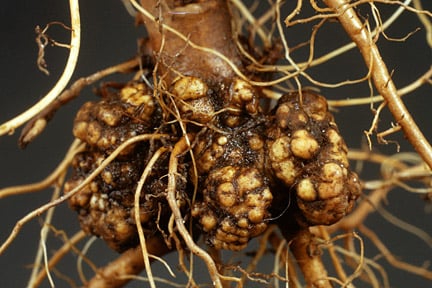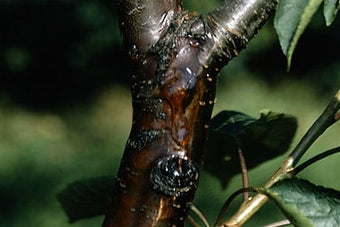
Quick facts
Common name - Crown gall
Scientific name - Rhizobium radiobacter(synonym Agrobacterium tumefaciens)
Plants affected - Many plants
Main symptoms - Knobbly swollen galls on stems, roots, trunks and branches
Caused by - Bacterium
Timing - Galls present all year
What is crown gall?
Crown gall is a disease caused by the bacterium Rhizobium radiobacter (synonym Agrobacterium tumefaciens), which enters the plant through wounds in roots or stems and stimulates the plant tissues to grow in a disorganised way, producing swollen galls. Galls are present all year.
Crown gall affects many plants, both woody and herbaceous, although attacks are often very sporadic and confined to just one or two plants. These are some of the plants on which it is found most commonly:
- Fruit: Apples, cherries, currants, gooseberries, grapevines, blackberries, peaches, pears, plums and quince
- Vegetables: Beetroot, courgettes, runner beans and swedes
- Herbaceous plants:Alcea (hollyhock), Argyranthemum (marguerite), Begonia, Dahlia, Lathyrus (sweet pea), Lupinus (lupin) and Phlox
- Woody plants:Crataegus (hawthorn), Euonymus, Populus (poplar), Salix (willow), Rosa and Ulmus (elm)
Note: swellings caused by crown gall should not be confused with the harmless nitrogen-fixing nodules produced on the roots of many members of the pea family.
Symptoms
You may see the following:
- Swellings (galls) on the plant stems or roots. In severe cases almost all the root system may be replaced by massive, swollen tissues
- Galls on herbaceous plants decay and soon disintegrate, but those on woody plants may be hard and
- Plant growth may be affected, but often there is little apparent damage and root galls may go unnoticed for long periods
- Occasionally galls may form higher up a plant on the branches

Control
If crown gall is detected you may wish to remove and dispose of the affected plant, particularly if the galling is adversely affecting the plant's vigour or you find the symptoms too unsightly. This doesn't always need to be done, though. For example, a large tree, shrub or climber with just a small amount of galling could continue to grow and perform well despite the presence of the disease. As mentioned previously, crown gall is very sporadic in occurrence, so whilst there is some risk of spread from an affected plant it's often the case that neighbouring plants remain healthy. Galls that form on branches can be pruned out, cutting back to a point well below the gall.
If an affected plant is removed, growing crops of potatoes or other vegetables (except beetroot, which are also susceptible) over the next one or two years will help eliminate the bacteria from the soil, or you could grass the area over for one or more years.
Biology
The crown gall pathogen Rhizobium radiobacter inhabits the soil where it can survive for long periods. Not all strains of this bacterium are pathogenic (capable of causing disease) and there are several different pathogenic strains with differing host ranges.
The bacteria enter stems or roots through wounds. The bacterial DNA combines with the DNA of the plant host cell where it ‘transforms’ the cell, causing it to become tumour-forming (galls) and also to produce specific new materials on which the bacteria feed. As the gall grows, the plant tissues become disorganised and normal transport processes are disrupted.
In herbaceous plants, the gall rots and the bacterial cells return to the soil. On woody plants, the galls are woody and and do not rot away.





